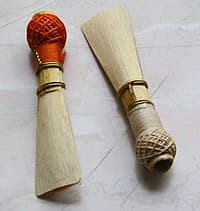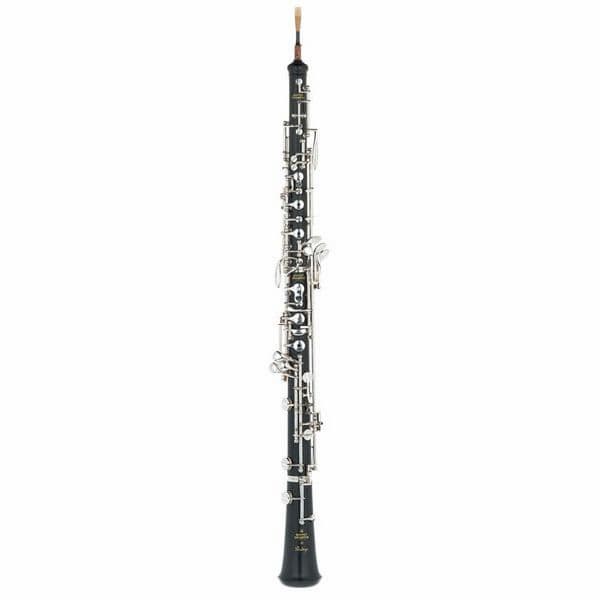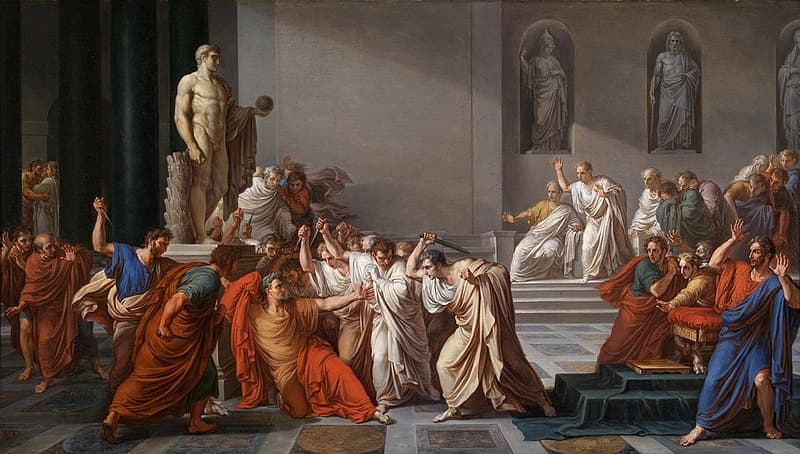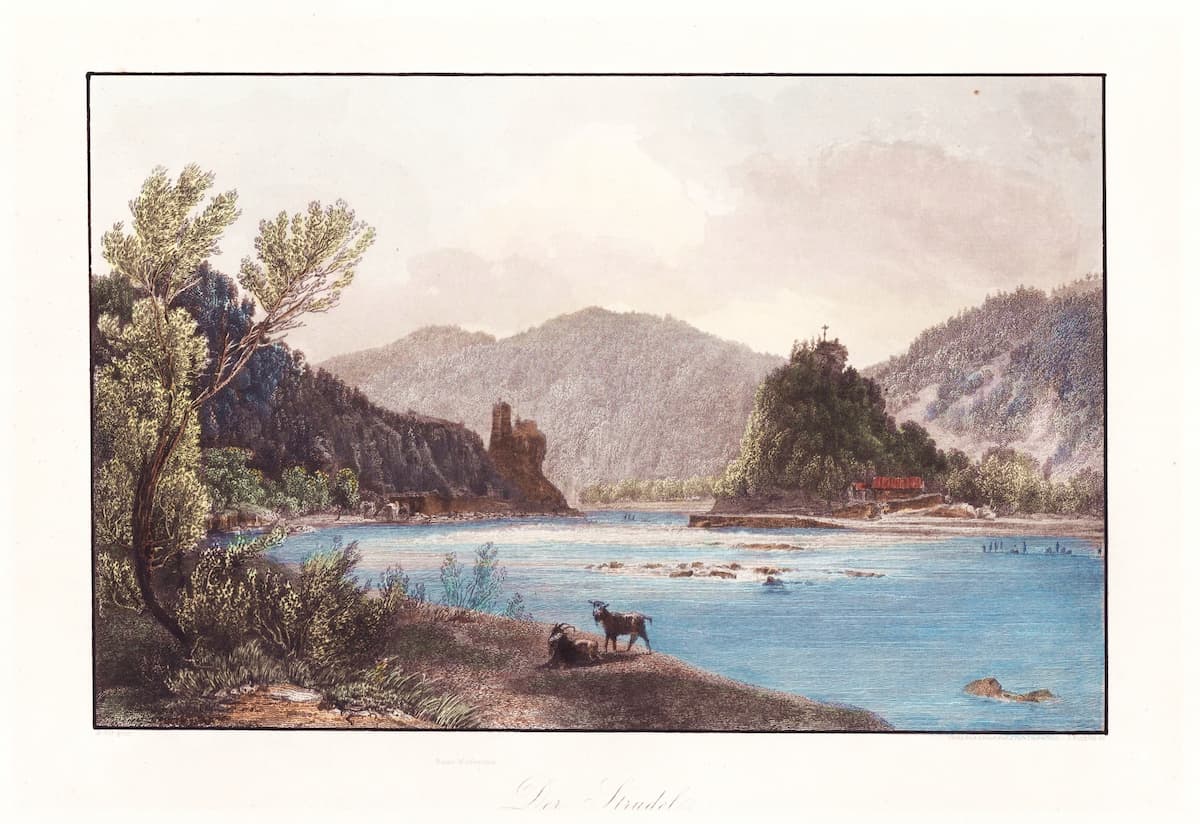The oboe is the first of the double-reed instruments. Unlike the clarinet, which holds a single reed against a hard mouthpiece, the double-reed instruments bind two curved reeds together as the mouthpiece. This gives a very different sound than that of clarinet – buzzier and slightly more nasal. It also gives the player control of the reed in more directions: top, bottom, and sides.

Double reeds – here, bassoon reeds
The reeds themselves come from a cane, Arundo donax, that is found all over the world, from Asia, southern Europe, northern Africa, and the Middle East. In ancient times, the best reeds came from Greece in the area around Athens.
The original oboe was known by its French name, Hautbois, or high wood. The French name went into Italian as oboe and from there into English as oboe. As with all woodwinds, the original instrument started as a tube with holes. The use of the double-reed to produce the sound was the hautbois’ unique quality. Gradually, more keys were added to improve the sound, and the bore was narrowed for easier playing, and the oboe came into the classical orchestra.
Here we can see the progression from the Renaissance oboe, with its 8 holes, to the Baroque oboe with 3 keys, here shown as a modern copy by Olivier Cottet that starts to have keys and split holes – note that the central key could be played by either the left or right hand. And then the modern oboe, here made by Buffet Crampon – with the modern narrow bore with up to 45 pieces of keywork added to the black wooden instrument.

Renaissance Oboe

Baroque Oboe

Modern Oboes
The oboe is a very expressive instrument with a sound that can pierce through the orchestra; it is frequently used for solo lines within the orchestra. It’s in the Baroque that it’s first used as a solo instrument, and in Bach’s Oboe Concerto in D minor, we can hear how he treats the oboe and the violin as equal partners. This work was lost for many years and was only known in its arrangement for 2 harpsichords and orchestra, but the reconstruction of the lost original was possible because the musical lines were clearly for oboe and violin.
J.S. Bach: Oboe Concerto in C minor, BWV 1060 – I. Allegro (Heinz Holliger, oboe; Gidon Kremer, violin; Academy of St. Martin in the Fields Orchestra; Heinz Holliger, cond.)
Tomaso Giovanni Albinoni (1671–1751) was one of the great Italian oboe composers, writing concertos for single and double oboes. The Basilica of San Marco in Venice had an oboe player by 1698, and it was part of the teaching curriculum at the ospedali grandi, the institutions for foundlings and orphans where Vivaldi was so memorably a music teacher. Whereas Vivaldi treated the oboe like a wind violin, his contemporary Albinoni used his experience as a singer to inform his compositions for the oboe – he not only provided breathing space (something that Vivaldi had to be reminded about) for the player but also wrote in a more idiomatic fashion, using conjunct movement and small intervals, where Vivaldi was more fond of the wide skips that violinists could do so easily.
Albinoni’s Opus 9 concertos show his mastery of the form and the instrument. The last movement of Op. 9, no. 5, in particular, is a lovely Allegro dance.
Tomaso Giovanni Albinoni: Oboe Concerto in C Major, Op. 9, No. 5 – III. Allegro (Anthony Camden, oboe; London Virtuosi; John Georgiadis, cond.)
Mozart wrote his only oboe concerto in 1777, and when he arrived in Mannheim on 30 October 1777, he gave it as a present to the oboist of the court orchestra, Friedrich Ramm, who was delighted with it. By February 1778, Ramm had presented it no less than 5 times in concert, as Wolfgang proudly wrote to his father.
The slow movement provides the oboist with the opportunity for a grand solo oboe aria.
Wolfgang Amadeus Mozart: Oboe Concerto in C Major, K. 271k / K. 314 – II. Andante ma non troppo (Martin Gabriel, oboe; Vienna Mozart Academy; Johannes Wildner, cond.)
Mozart also wrote the Oboe Quartet, probably also for Ramm, around the same time. Here, the oboe and the violin are paired extensively, and Mozart writes yet another of his wonderful melodies.
Wolfgang Amadeus Mozart: Oboe Quartet in F Major, K. 370 – III. Rondeau: Allegro (József Kiss, oboe; Kodály Quartet)
George Frideric Handel (1685–1759), following his Italian tour, wrote three oboe concertos, some for Germany and some for London.
George Frideric Handel: Oboe Concerto No. 3 in G Minor, HWV 287 – IV. Allegro (Anthony Camden, oboe; City of London Sinfonia; Nicholas Ward, cond.)
The oboe continued to be a solo instrument in the 19th century but was sidelined by the greater popularity of the piano and the violin. It was in the 20th century that the oboe again started to take center stage, such as in Camille Saint-Saëns’ Oboe Sonata from 1921. Saint-Saëns (1835–1921) wrote the work shortly before his death, and the writing is very old-fashioned, almost Classical in its sound yet with a definite modern edge.
Camille Saint-Saëns: Oboe Sonata in D Major, Op. 166 – III. Molto allegro (Katsuya Watanabe, oboe; David Johnson, piano)
Francis Poulenc (1899–1963) also wrote his Oboe Sonata as one of his last works. Although the first movement, Elegy, has a delicate peacefulness, it’s the last movement, Déploration, that brings out the melancholy side of the oboe in a sad lament.
Francis Poulenc: Oboe Sonata, FP 185 – III. Déploration: Très calme (Olivier Doise, oboe; Alexandre Tharaud, piano)
English composers such as Benjamin Britten, Arnold Bax, and Arthur Bliss wrote for the oboe, each of them writing for oboe and small ensemble, such as a string quartet.
Bliss’ quartet for oboe and string quartet makes a point of contrasting the string textures with the oboe sonorities. The oboe part can be warm and lyrical, but Bliss isn’t afraid to ask for the oboe’s high register, which can be more penetrating.
Arthur Bliss: Oboe Quintet – III. Vivace (Gordon Hunt, oboe; Tale Quartet)
American composer Elliott Carter (1908–2012) brought the oboe into the 21st century with his Oboe Quartet, written in 2001. Written for the oboist Heinz Holliger, for whom Carter also wrote his Oboe Concerto in 1987 and his Trilogy for Oboe and Harp in 1991, the work builds on Carter’s harmonic vocabulary of 6- and 8-note chords.
Elliott Carter: Oboe Quartet (Stephen Taylor, oboe; Curtis Macomber, violin; Maureen Gallagher, viola; Eric Bartlett, cello)
Where the earlier composers used the oboe for its lyrical and singing quality, modern composers wrote for the wide range of oboe sonorities – brash, piercing, and sometimes even nasal. The instrument took on a new character that could only make its appeal wider.
For more of the best in classical music, sign up for our E-Newsletter


